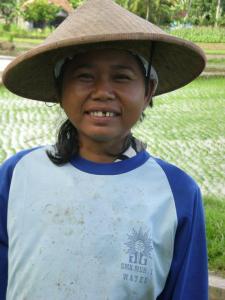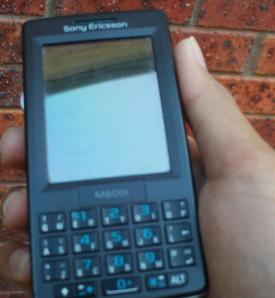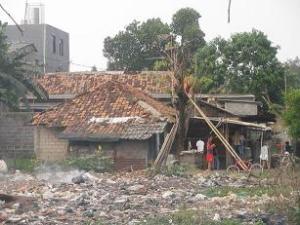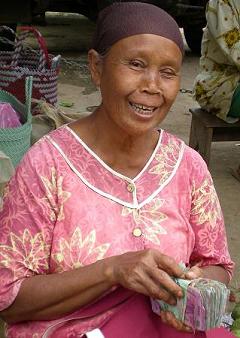Bulan Nopember 2007, presiden Susilo Bambang Yudoyono meluncurkan Kredit Usaha Rakyat (KUR) yang merupakan implementasi dari Instruksi Presiden No. 6 Tahun 2007 tanggal 8 Juni 2007 tentang Kebijakan Percepatan Pengembangan Sektor Riil dan Pemberdayaan UMKM dan Nota Kesepahaman Bersama antara Pemerintah, Perbankan dan Perusahaan Penjaminan pada tanggal 9 Oktober 2007. Pemerintah menujuk 6 bank pelaksana KUR yakni Bank BRI, Bank Mandiri, Bank BNI, Bank BTN, Bank Bukopin dan Bank Syariah Mandiri. Bank-bank tersebut merupakan sahamnya dimiliki oleh pemerintah dan 4 bank diantaranya telah menjadi perusahaan terbuka.
 KUR sudah berjalan lebih dari 1 tahun namun hingga sekarang belum ada evaluasi yang menyeluruh tentang efektivitasa dan manfaat program tersebut terhadap pertumbuhan ekonomi dan pengurangan angka kemiskinan. Evaluasi tersebut sangat penting jangan sampai KUR dibelokkan menjadi alat kampanye politik pada ajang Pemilu dan Pilpres 2009. Penulis ini tidak bermaksud menilai kinerja KUR secara tehnis perbankan karena itu merupakan domain Bank Indonesia. Namun artikel ini merupakan hasil pengalaman langsung penulis sebagai (mantan) praktisi perbankan yang memasarkan, mengelola portofolio KUR dan membina para debitur wirausaha mikro dan kecil di daerah Jawa Tengah.
KUR sudah berjalan lebih dari 1 tahun namun hingga sekarang belum ada evaluasi yang menyeluruh tentang efektivitasa dan manfaat program tersebut terhadap pertumbuhan ekonomi dan pengurangan angka kemiskinan. Evaluasi tersebut sangat penting jangan sampai KUR dibelokkan menjadi alat kampanye politik pada ajang Pemilu dan Pilpres 2009. Penulis ini tidak bermaksud menilai kinerja KUR secara tehnis perbankan karena itu merupakan domain Bank Indonesia. Namun artikel ini merupakan hasil pengalaman langsung penulis sebagai (mantan) praktisi perbankan yang memasarkan, mengelola portofolio KUR dan membina para debitur wirausaha mikro dan kecil di daerah Jawa Tengah.
Misleading Kredit Tanpa Agunan
Terminologi kredit tanpa agunan atau kredit tanpa jaminan kerap kali diwacanakan oleh berbagai kalangan, bahkan ada bank yang menggunakan buzzword kredit tanpa agunan (KTA) untuk tujuan pemasaran sehingga menimbulkan kerancuan dan salah persepsi dikalangan masyarakat yang menganggap untuk mendapatkan kredit tidak perlu ada agunan. Padahal UU Perbankan secara tegas menyatakan bank dilarang memberikan kredit tanpa agunan. Artinya, setiap sen kredit yang disalurkan harus dijamin risikonya oleh debitur yakni berupa objek atau aktivitas bisnis yang dibiayai sebagai agunan utama. Bahkan di ranah praktis, bank mensyaratkan adanya agunan tambahan yang memiliki nilai lebih seperti fixed assets, financial assets dll untuk menambah keyakinan risiko kerugian menjadi nihil. Dalam konteks ini, jika ada bankir yang memberikan kredit tanpa agunan maka dipastikan ybs melanggar prinsip kehati-hatian dalam penyaluran kredit yang berimplikasi pada aspek hukum.
Bagaimana dengan KUR yang gencar dipromosikan sebagai kredit tanpa agunan atau kredit yang dijamin oleh pemerintah. Sesungguhnya KUR tidak melanggar aturan atau best practice perbankan karena skim pembiayaan ini dirancang dengan pola penjaminan asuransi kredit. Untuk tujuan tersebut pemerintah menyuntikan dana kepada dua BUMN yakni PT. Askrindo dan Perum Jaminan Kredit Indonesia (Jamkrindo) sebagai penjamin kerugian bank apabila KUR tersebut bermasalah dengan pola 70% dari nilai kredit merupakan tanggungan pemerintah (Askrindo dan Jamkrindo), sedangkan 30% sisanya menjadi risiko bank pelaksana KUR.
Ada study yang dilakukan oleh peneliti dari Rural Finance Ohio State University Amerika Serikat yang menarik untuk diperhatikan bahwa sistim penjaminan kredit memberikan manfaat positif bagi masyarakat, perbankan dan perekonomian karena membuka akses yang lebih besar kepada calon nasabah yang tidak memiliki agunan atau mempermudah existing debitur untuk menambah jumlah kredit yang terkendala agunan kurang mencukupi. Dampak lainnya yakni mendorong bank lebih aktif memberikan kredit dengan jangka waktu panjang sehingga lebih menstimulai sektor investasi, menurunkan suku bunga karena sebagian atau semua risiko dijamin dengan demikian risk premium akan rendah. Adanya penjaminan kredit dapat mempercepat proses kredit sebab dipangkasnya prosedur penilaian jaminan yang rumit dan pada akhirnya menurunkan transaction cost. Kesimpulan senada juga disampaikan oleh Financial Sector Team DID Inggris yang meneliti sistim penjaminan kredit di beberapa negara berkembang seperti Chile, India, Mesir dan Polandia yakni kredit dengan dukungan sistim penjaminan yang dikelola dengan baik tanpa vested interest dapat mengakselerasi financial deepening dan memberikan manfaat besar bagi perekonomian, peningkatan business cycles and investment, penyerapan tenaga kerja serta income generation khususnya di sektor UMKM.
Pada dasarnya masyarakat tidak perlu khawatir dan meragukan manfaat KUR. Akan tetapi yang perlu diperhatikan adalah bagaimana pemerintah menjalankan, mengawasi dan mensosialisasikan kepada masyarakat secara benar dan proporsional. Seyogyanya promosi dan sosialisasi KUR yang menggunakan gimmicks kredit tanpa agunan atau kredit yang dijamin oleh pemerintah secara berlebihan tampaknya kurang tepat dan perlu disampaikan secara jelas kepada masyarakat karena menimbulkan misleading atau salah penafsiran yang berimplikasi pelaksanaan di lapangan. Contoh yang aktualnya adalah protes dari para calon debitur yang merasa dipersulit oleh bank karena mensyaratkan adanya agunan utama (usaha yang dibiayai). Kondisi ini juga ditunggangi oleh pihak-pihak tertentu yang turut menekan bank dengan alasan menysukseskan program pemerintah atau membela kepentingan rakyat miskin. Implikasi lain yang harus diperhatikan adalah moral hazard debitur dan para bankir itu sendiri. Ada semacam pemahaman masyarakat bahwa kredit yang dijamin oleh pemerintah merupakan charity atau bantuan sosial yang tidak wajib untuk dikembalikan hingga lunas. Bankir juga dapat melakukan moral hazard dengan mengabaikan azas kehati-hatian karena merasa “aman”. Kita semua yakin bahwa pemerintah sekarang tampaknya lebih smart dan tidak akan mengulangi bad practice di masa lalu yang menggunakan kredit program untuk meraih posisi politik terlebih lagi menjelang Pemilu. Politisasi kredit bersubsidi akan menimbulkan konsekwensi negatif yaitu penurunan kinerja perbankan dan remedial treatments yang mahal serta memakan waktu lama.
Kinerja KUR
Pada awal peluncurannya, skim KUR adalah kredit usaha mikro dan kecil de ngan plafond UMKM sampai dengan Rp. 500 juta (dalam penulisan ini disebut KUR-Kecil). Kemudian pada bulan Februari 2008, dikembangkan lagi satu skim KUR-Mikro dengan plafond dibawah Rp. 5 juta sebagai respon dari kecenderungan bank pelaksana untuk melayani nasabah dengan plafond kredit besar karena untuk mempertahankan skala ekonomi dan efisiensi sehingga tujuan awal peluncuran KUR untuk membuka akses bagi kelompok usaha mikro dan kecil yang belum bankable tidak optimal. Berbeda dengan KUR-Kecil, pelayanan KUR-Mikro hanya dilaksanakan oleh Bank BRI dengan pertimbangan jaringan kerja Bank BRI dengan BRI Unit nya tersebar luas hingga ke pelosok kecamatan agar dapat menjangkau calon-calon debitur usaha mikro dalam jumlah besar, selaras dengan kebijakan pro growth, pro job & pro poor.
Berdasarkan publikasi Kompas, posisi KUR per November 2008 sebesar Rp 12,03 triliun yang disalurkan kepada 1,6 juta debitur dengan komposisi KUR dengan nominal di atas Rp 5 juta sebesar Rp 2,85 triliun dan KUR < Rp 5 juta senilai Rp 5,75 triliun (1,48 juta debitur). Sektor usaha yang menjadi primodona penyaluran KUR adalah sektor perdagangan, restoran, dan hotel dengan pangsa pasar 60,13%, diikuti oleh sektor pertanian sebesar 21,26%, sektor jasa 3,27% dan dalam porsi kecil ke sektor lainnya.
Dari 6 bank pelaksana KUR, Bank BRI merupakan penyalur terbesar yakni sebanyak 1,5 juta debitor atau 96,17 persen. Kemudian diikuti oleh Bank Mandiri sebanyak 36.974 debitor (2,52 persen), BNI 8.982 debitor (0,61 persen), Bank Syariah Mandiri sebanyak 5.956 debitor (0,43 persen), dan Bank Bukopin sebanyak 2.952 debitor (0,2 persen).
Sayangnya data yang tersedia belum menampilkan angak-angka detail distribusi menurut propinsi dan kualitas KUR (NPL) serta nilai klaim kredit yang telah dibayarkan oleh Askrindo dan SPU. Ketersediaan data yang lengkap, akurat dan up to date merupakan elemen penting dalam mengevaluasi dan monitoring kinerja KUR secara utuh. Bahkan menurut pandangan penulis, pemerintah atau para stakeholders lainnya perlu melakukan impact assessment untuk mengetahui efektifitas KUR terhadap peningkatan bisnis, kesejahteraan nasabah dan dinamika sosio-ekonomi setempat. Evaluasi seperti ini sangat lazim dilakukan untuk mengukur keberhasilan program-program kredit mikro bersubsidi yang bersumber dari dana pemerintah atau bantuan lembaga donor internasional.
Mempeluas Akses KUR
Statistik yang dikeluarkan oleh Menegkop dan BPS menyebutkan ada 42 juta unit bisnis mikro dan kecil tersebar di negeri ini dengan berbagai variabilitas berdasarkan jenis usaha, perputaran bisnis, tingkat viability dan sustainability. Namun demikian belum ada catatan mengenai jumlah usaha mikro dan kecil yang telah mendapatkan pembiayaan perbankan atau lembaga keuangan. Menurut pendapat penulis terdapat fenomena “gunung es” (iceberg of credit) dalam struktur pembiayaan UMKM, yakni sebagian besar usaha mikro dan kecil yang feasible belum mendapatkan akses kredit perbankan yang memadai karena terkendala status unbankable dan tidak memiliki agunan yang bernilai ekonomi tinggi (lihat gambar).
Selanjutnya dengan membandingkan data penyaluran KUR dan jumlah unit usaha UMKM jelas tampak adanya gap pembiayaan tersebut sehingga sangat tepat apabila KUR posisinya makin diperkuat sebagai “jalan tol” bagi wirausaha mikro dan kecil untuk mengakses kredit perbankan guna pengembangan bisnis yang sudah berjalan baik. Selain itu KUR harus diarahkan sebagai exit strategy dari program dana bergulir yang banyak dikelola oleh departemen dan lembaga pemerintah untuk pemberdayaan masyarakat misalnya PNPM dan pengembangan usaha pemula (start-up business) sehingga mereka tidak layu sebelum berkembang karena keterbatasan modal serta antisipasi untuk mengatasi dampak krisis keuangan global.
Ada tiga langkah strategis yang harus segera dilaksanakan agar akses dan akselerasi penyaluran KUR dapat optimal.
Pertama, pemerintah secara simultan melibatkan perbankan nasional untuk menyalurkan KUR ke sektor-sektor produktif. Dari kata mata bisnis, menyalurkan KUR cukup menguntungkan. Dengan suku bunga kredit sebesar 24% untuk KUR-Mikro dan rata-rata 14%-16% untuk KUR-Kecil, bank pelaksana akan mendapatkan keuntungan yang memadai setelah dikurangi biaya operasional dan risiko kredit sebesar 30%. Hitungan kasar profit margin yang diperoleh berkisar antara 4% hingga 10% tergantung dari cost of fund dan biaya overhead masing-masing bank. Keuntungan tersebut tentu cukup menarik terlebih lagi bagi bank yang telah terjun melayani segmen UMKM seperti Bank BPD, Bank Danamon, Bank Panin, Bank Mega, Bank NISP dll.
Perluasan akses KUR dengan melibatkan bank umum akan membawa keuntungan bagi wirausaha UMKM, sektor perbankan dan pemerintah. Sisi positifnya anatara lain peningkatan kinerja pelayanan dan penurunan suku bunga sebagai dampak dari kompetisi antara bank yang menyalurkan KUR; Menstimulasi fungsi intermediasi perbankan dan loan to deposit ratio (LDR) yang selama ini masih relatif rendah karena bank condong bersikap risk averse melalui penempatan dana di Bank Indonesia dari pada menyalurkan kredit ke sektor bisnis terutama di masa krisis seperti saat ini. Bagi pemerintah, multiple credit points yang diperoleh adalah mengurangi tekanan politik dari berbagai pihak yang menentang program KUR. Keterlibatan perbankan nasional akan melemahkan tuduhan bahwa pemerintah mempolitisasi bank milik pemerintahnya dan afiliasinya yang saat ini secara ekslusif ditunjuk untuk menalurkan KUR. Tidak kalah pentingnya dimata para investor pasar modal, pemerintah akan mendapatkan apresiasi positif karena tidak terlalu membebani empat bank milik pemerintah yang telah go public dengan misi sebagai agent of development.
Ada contoh tepat untuk dijadikan acuan oleh pemerintah yakni di Thailand. Negara tetangga Asean ini berhasil mengembangkan Small Industry Credit Guarantee Corporation (SICGC) yang mayoritas sahamnya dimiliki oleh Kementrian Keuangan. Lembaga SICGC berfungsi menjamin kredit mikro dan kecil perbankan dengan mekanisme penjaminan relatif sederhana dan terbuka bagi semua bank untuk berpartisipasi asalkan memenuhi persyaratan dan membayar guarantee fee yang ditetapkan. Pola ini sangat fleksibel dan cukup berhasil mendorong kredit perbankan kepada bisnis mikro dan kecil di negara tersebut.
Langkah kedua, menambah channel penyaluran KUR dengan menyertakan lembaga keuangan yang dimiliki oleh pemerintah seperti Perum Pegadaian, Bahana Ventura, PNM dan lembaga venture capital milik Pemda. Secara komulatif kapasitas dan jumlah jaringan lembaga-lembaga tersebut cukup luas serta cukup berpengalaman dalam menyalurkan pembiayaan kepada UMKM. Misalnya, Pegadaian saat ini telah memiliki skim kredit mikro (Kreasi) yang dijamin oleh Askrindo secara komersial (premi asuransi dibayar oleh nasabah). Lembaga keuangan ini lebih fleksibel dalam menyalurkan KUR karena tidak terikat oleh aturan Bank Indonesia yang ketat. Pemerintah pun akan lebih mudah melakukan pengawasan dan pengendalian karena merupakan BUMN sehingga benturan kepentingan dengan pihak lain sangat minimal.
Langkah ketiga, segera melaksanakan dan memperkuat linkage program bank umum dengan bank perkreditan rakyat (BPR) dan bank umum dengan lembaga keuangan mikro (LKM) untuk menyalurkan KUR-Mikro. Bank-bank umum yang berpartisipasi dalam program KUR sebaiknya diwajibkan menyalurkan KUR-Mikro dengan pola linkage tersebut dan mengembangkan sistim pemeringkat untuk menilai LKM yang sehat dari sisi kinerja keuangan, organisasi dan memiliki kemampuan menyalurkan KUR-Mikro secara sustainable.
Menurut survei The Consultative Group to Assist the Poorest (CGAP), salah satu lembaga afiliasi Bank Dunia untuk keuangan mikro, bahwa banyak usaha mikro dan orang miskin yang tidak mendapatkan akses keuangan karena mereka berada diluar “target sasaran” lembaga keuangan mikro dan program pemberdayaan orang miskin, kelompok ini disebut dengan missing middle. Sebagai contoh, penulis banyak menemukan pedagang-pedagang di pasar tradisionil masih banyak terjerat oleh rentenir dan kredit harian yang bunganya mencekik leher. Sebagian besar petani gurem terjerat ijon karena sulit mengakses kredit pertanian karena bank semakin selektif melayani pembiayaan pertanian pangan dan palawija. Di lapangan juga dijumpai banyak kelompok usaha perempuan, kelompok peternak dan kelompok nelayan yang kebingungan mencari modal usaha karena program dana bergulir telah dihentikan atau dialihkan ke sektor lain atau kelompok baru. Dengan linkage program bank umum dan LKM diharapkan mereka dapat mengakses KUR-Mikro karena LKM seperti Baitul Mal Wa’tamwil, (BMT), Lembaga Perkreditan Desa (LPD) di Bali, Badan Kredit Desa (BKD) di pulau Jawa dan Madura, Lumbung Pitih Nagari (LPN) di Sumatera Barat dan Koperasi (KSP dan USP) yang berjumah ribuan unit dan beroperasi sangat dekat dengan masyarakat di desa-desa dan di kantong-kantong kemiskinan yang jauh dari jangkauan bank bahkan oleh BRI Unit sekalipun.
Kita berharap perluasan penyaluran KUR dapat menjangkau wirausaha mikro dan petani yang membutuhkan dana untuk usaha produktif dan tidak dibelokan menjadi alat politik seperti yang selalu terjadi dimasa lalu.
Salam
Iwan Nazirwan
Melbourne, Jan 2009


 KUR sudah berjalan lebih dari 1 tahun namun hingga sekarang belum ada evaluasi yang menyeluruh tentang efektivitasa dan manfaat program tersebut terhadap pertumbuhan ekonomi dan pengurangan angka kemiskinan.
KUR sudah berjalan lebih dari 1 tahun namun hingga sekarang belum ada evaluasi yang menyeluruh tentang efektivitasa dan manfaat program tersebut terhadap pertumbuhan ekonomi dan pengurangan angka kemiskinan.